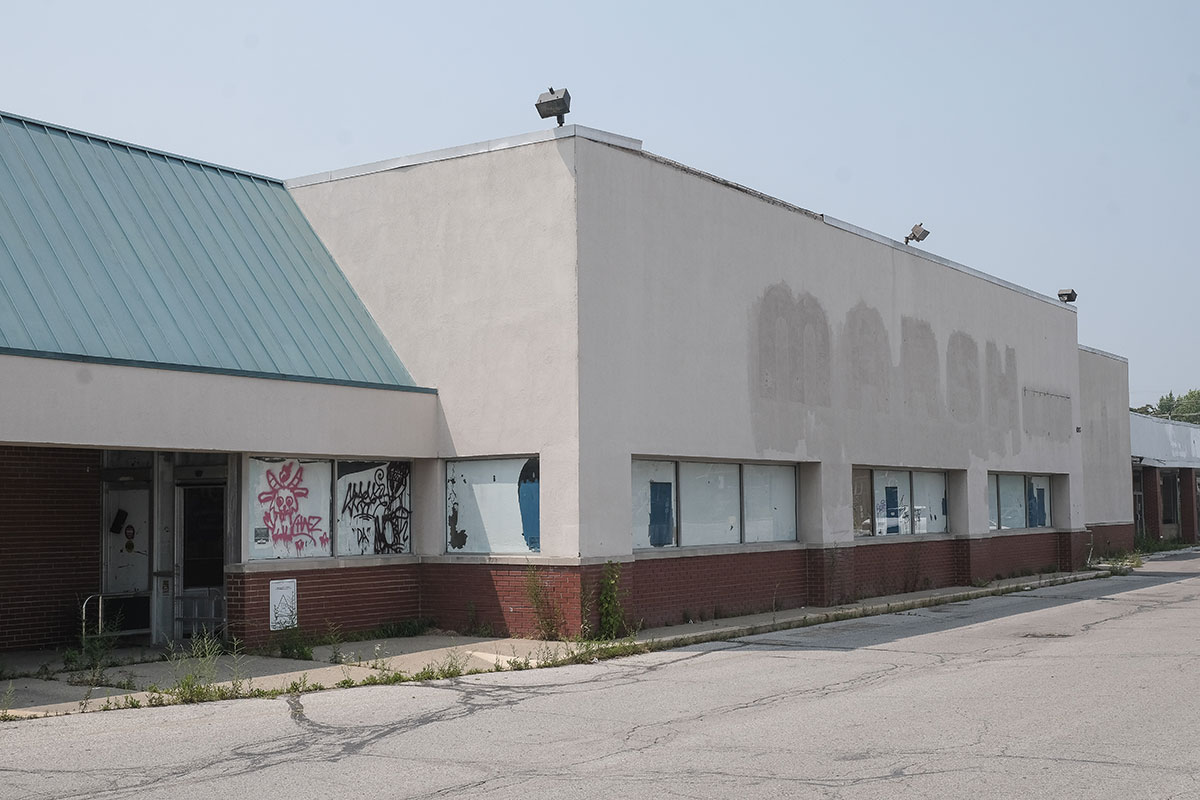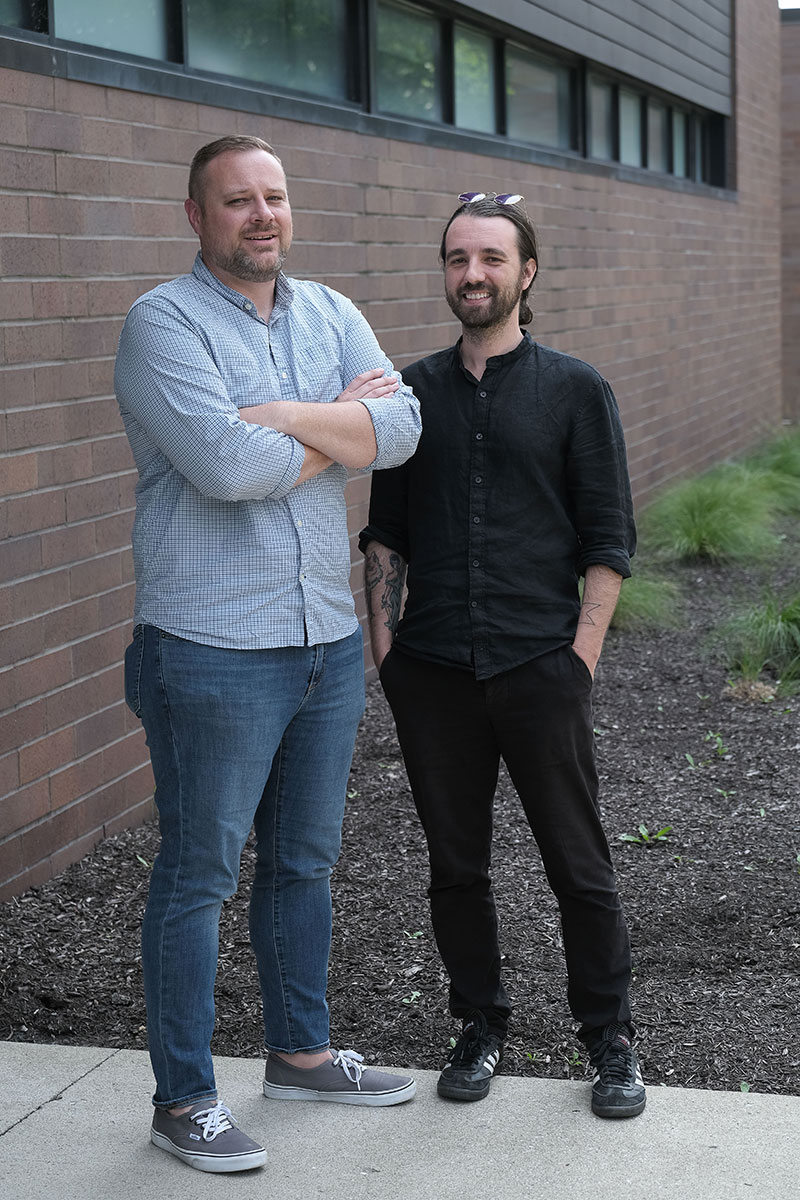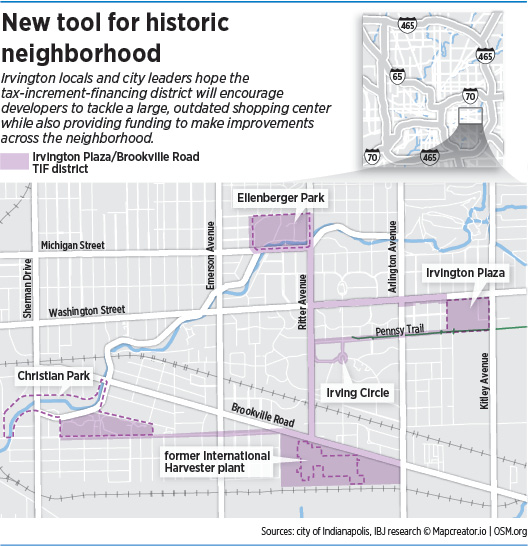Subscriber Benefit
As a subscriber you can listen to articles at work, in the car, or while you work out. Subscribe NowWhen Jim Rawlinson was growing up across the street from Irvington Plaza in the 1980s, he might head to the Marsh grocery store and then stop by the Dairy Queen after.
The Dairy Queen is the only relic of that era remaining at the strip mall in the 6200 block of East Washington Street. Rawlinson is now vice president of the Irvington Development Organization, and the shopping mall property appears to him to be the last opportunity for a large affordable-housing complex in the historic neighborhood.
The property’s Florida-based property owner said he’s willing to sell—for the right price—so it can be redeveloped. It just needs a buyer.
A revitalization of the 15-acre property has been years in the making. In 2019, the city paid the Urban Land Institute $135,000 to study the site, yielding a speculative plan for mixed-use development.
No deals followed, but the City-County Council’s approval in April of an Irvington Plaza/Brookville Road tax-increment-financing district has given city officials and Irvington residents hope for progress.
The TIF district will allow some property taxes to be diverted to support public projects and development in the area.

The strip mall was built in 1952 and for years served as a primary retail hub for the neighborhood. However, it has been on the decline since the 1980s, and in May 2017 lost a 32,000-square-foot Marsh supermarket.
After the Marsh closed, several other retailers vacated the shopping center, Irvington City-County Councilor Jason Larrison told IBJ. The boarded-up Marsh space is frequently broken into, Larrison said, and a nearby vacant building caught fire in August 2021 when squatters attempted to cook on a grill inside the structure.
“It’s for the most part a large parking lot surrounded by vacant buildings,” he said.
Jordan Gleason, president of the Irvington Development Organization, said the tax-increment-financing district is a big deal.
“Not a lot of development dollars flow into the east side, unfortunately, and I feel like that plaza is just this undeveloped eyesore,” Gleason said.
The TIF district will collect incremental property taxes (any growth over current taxes) paid within the designated area and allow those new dollars to be applied to projects like infrastructure and publicly backed developments focused on housing affordability.
State law also allows TIF dollars to be used to tackle environmental cleanup, land costs, and the acquisition, demolition or rehabilitation of certain structures.

The use of tax-increment financing was recommended in the 2019 land institute report. It also proposed a vision that includes ample green space, lofts and apartments that sit over commercial spaces, and urban town houses. The report also studied land surrounding the strip mall, covering 27 acres.
Under the land institute’s proposal, Irvington Plaza would retain its name and include an outdoor plaza with seating, kiosks and pop-up stands, with enough space for a winter ice skating rink and a summer splash pad.
The Dairy Queen should be moved to a more prominent location for pedestrian- and family-friendly activities, the report said. It currently sits alone in the middle of the parking lot, adjacent to neither Washington Street or the Pennsy Trail.
“I think these documents still hold true,” Larrison told IBJ. “These are still the same things that neighbors and constituents talk about over here.”
A developer wouldn’t be required to follow the land institute plan, but the Department of Metropolitan Development might push in that direction when agreeing to provide city support, Deputy Mayor of Development Scarlett Andrews told IBJ in April.
Leasing? Selling?
There might be movement on the Irvington Plaza site unrelated to efforts from the city and the Irvington Development Organization.
A listing from real estate firm CBRE has the 15-acre property up for lease. It mentions a redevelopment that maintains the space as a shopping center but with a new grocery anchor. Shops in categories like household, hardware, pet, banking and medical are also in the lease pitch, along with opportunities for locally owned retailers. The CBRE broker handling listing could not be reached for comment.
Eric Becker, the Long Beach, Florida-based owner of the property, said he’s willing to sell it but that developers have to be ready for a “long, tedious process.”
“Over the years, I have tried [to find a buyer] through local brokers that have substantial influence in the area, and nobody really showed interest,” Becker said.
 But the IDO’s Gleason said developers have told him Becker’s asking price for years has been too high. And IDO hasn’t been able to reach him.
But the IDO’s Gleason said developers have told him Becker’s asking price for years has been too high. And IDO hasn’t been able to reach him.
“We’ve been trying to get on the telephone to talk to them for the last 10 years I’ve been on the board,” he said.
But Becker might be softening on his price, Gleason added: “I know developers have been getting much more positive reaction [recently] from that individual.”
Becker wouldn’t tell IBJ his asking price for the property. A land institute panel, which conducted over 65 interviews with local industry experts in 2019, estimated acquisition costs for the plaza at $6 million. Redevelopment costs associated with the land institute’s proposal would be about $111 million—not a feasible expense from a developer’s perspective, the report said.
City support
But once a private developer buys the property, the city could offer incentives to make the project more attractive, Andrews told IBJ in April.
“We have struggled for years trying to find a developer large enough to take on that [project] without some help from the city,” Gleason told IBJ. “So we’re glad to see the city coming in and providing some funds to purchase [the property] or place utilities, because it’s still utilities from the 1960s in that thing.”
A neighborhood advisory board will offer city officials suggestions on how to use the TIF funds. That board is currently being formed, a DMD spokesperson said.
Andrews told IBJ in April that the TIF map was drawn to strategically capture public spaces so funds could be used for infrastructure costs. The new financing tool will be used to help fund pedestrian-focused improvements, like updates to the Pennsy Trail, along with improvements in Christian Park, Ellenberger Park and Irving Circle.
The likely largest source of TIF revenue will be a 1.2 million-square-foot speculative logistics park being built by developer Ambrose at 5565 Brookville Road, the former site of an International Harvester plant.
Another factor that could spur development is the proposed IndyGo Blue Line, a bus rapid transit line that would extend from Cumberland on the east side to the west-side Indianapolis International Airport. Initial IndyGo plans called for completion in 2025, but design for the transit line was put on hold in August 2022 after the price tag was $300 million more than expected due to required sewer improvements.
If that transit line is eventually built, it will play into the DMD’s transit-oriented development overlay, which gives high-density affordable housing priority over other kinds of development.
Gleason said the combination of the TIF and the proposed IndyGo line should provide opportunities for more housing options. He cited the development of the 50-unit Irvington Lofts in 2011 as the last big housing addition in the community.
“We’re making sure we’re not leaving people behind,” Gleason said. “Giving people an opportunity to live here, and not get pushed out.”•
Please enable JavaScript to view this content.



This development needed a new owner, not a TIF.
It always surprised me the DQ stayed in business. It’s literally hidden behind an eye sore of buildings.
As am I, although I’m aware that most people in the area are aware of it and it is one of the few DQs that still have good service and consistent produce. I’m more surprised they ever even chose that lot to develop initially even when the plaza was more vibrant.
There needs to be shops and businesses along the Pennsy.